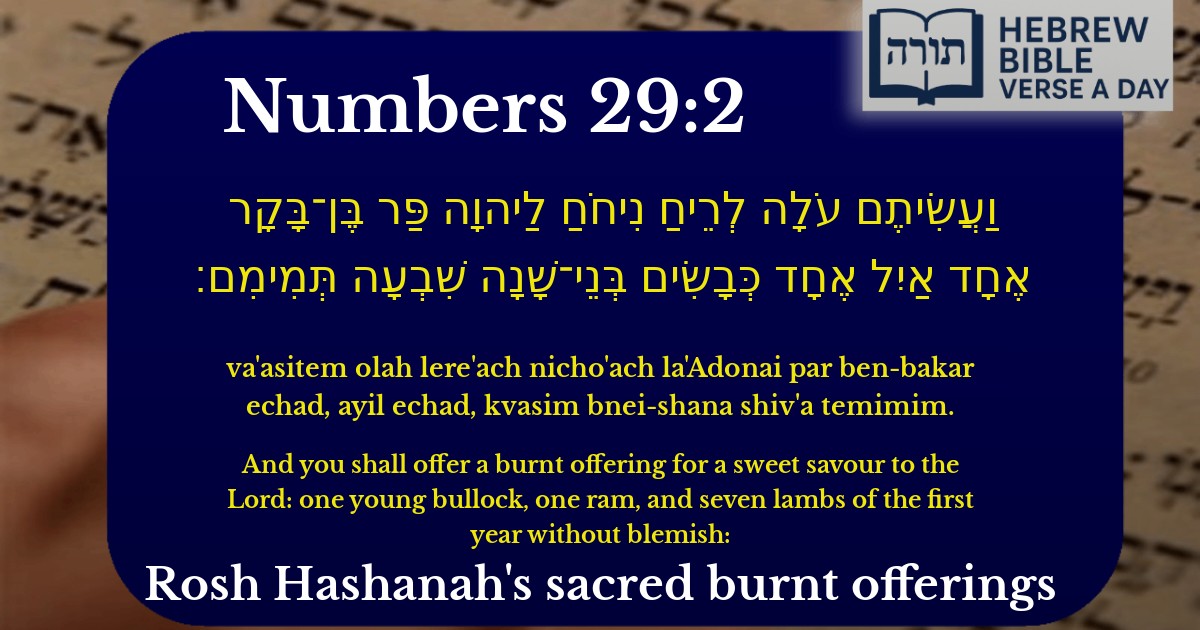Frequently Asked Questions
Q: What does Numbers 29:2 mean?
A: Numbers 29:2 describes the specific sacrifices to be brought as burnt offerings (olah) on Rosh Chodesh (the new month) during the holiday of Sukkot. The verse lists one young bull, one ram, and seven unblemished lambs in their first year. These offerings were meant to create a 'sweet savor' (reiach nichoach) to Hashem, symbolizing the Jewish people's devotion and desire to draw close to Him through service.
Q: Why are the animals required to be 'without blemish' (temimim)?
A: The Torah requires sacrifices to be physically perfect (temimim) because they represent our complete dedication to Hashem. Rashi explains that any defect in the animal would diminish the sincerity of the offering. Just as we strive for spiritual wholeness in serving G-d, the korbanot (offerings) must reflect that ideal of perfection.
Q: What is the significance of the 'sweet savor' (reiach nichoach) mentioned in this verse?
A: The term 'reiach nichoach' (sweet savor) appears frequently in the Torah regarding sacrifices. Ramban explains that it symbolizes Hashem's acceptance of the offering when brought with proper intent. The Talmud (Menachot 110a) teaches that the smell represents the sincerity of the person bringing the sacrifice—just as a pleasant smell is pleasing physically, a heartfelt offering is pleasing spiritually to G-d.
Q: How does this verse apply today when we no longer bring sacrifices?
A: Although we no longer bring physical sacrifices, the Talmud (Berachot 17a) teaches that prayer (tefillah) replaces sacrifices in our time. The Midrash (Vayikra Rabbah 7:3) also states that acts of kindness and Torah study are considered like offerings. Thus, the lesson of Numbers 29:2 applies today by reminding us to serve Hashem wholeheartedly through prayer, mitzvot, and good deeds—our modern 'offerings.'
Q: Why does the verse specify the exact number of animals (1 bull, 1 ram, 7 lambs)?
A: The precise quantities reflect the detailed halachic (Jewish legal) requirements for this particular offering. The number seven often symbolizes completeness in Jewish tradition (e.g., seven days of creation). Rashi notes that the additional lambs on Sukkot—compared to other holidays—reflect the special joy and abundance of this harvest festival, as Sukkot is called 'the time of our rejoicing' (z'man simchateinu).


The Nature of the Korban Olah
The verse describes the olah (burnt offering), which is entirely consumed on the altar, symbolizing complete devotion to Hashem. Rashi (Vayikra 1:9) explains that the term rei'ach nichoach ("sweet savour") indicates that the offering is pleasing to Hashem when the intentions of those bringing it are sincere. The Rambam (Moreh Nevuchim 3:46) adds that korbanot serve to direct human thoughts toward divine service, with the olah representing total submission to Hashem's will.
The Specific Animals Required
Spiritual Significance
The Talmud (Menachot 110a) teaches that one who studies the laws of the olah is considered as if they had brought it. This highlights the enduring relevance of korbanot even in times when the Beit HaMikdash is not standing. The Kli Yakar (Vayikra 1:9) explains that the olah atones for improper thoughts, emphasizing that inner repentance is essential alongside physical offerings.
Connection to Daily Service
This verse parallels the daily tamid offering (Bamidbar 28:1-8), which maintains a constant bond between Klal Yisrael and Hashem. The Ramban (Bamidbar 28:2) notes that consistent offerings reflect unwavering commitment, mirroring the perpetual flame of the menorah in the Mishkan.